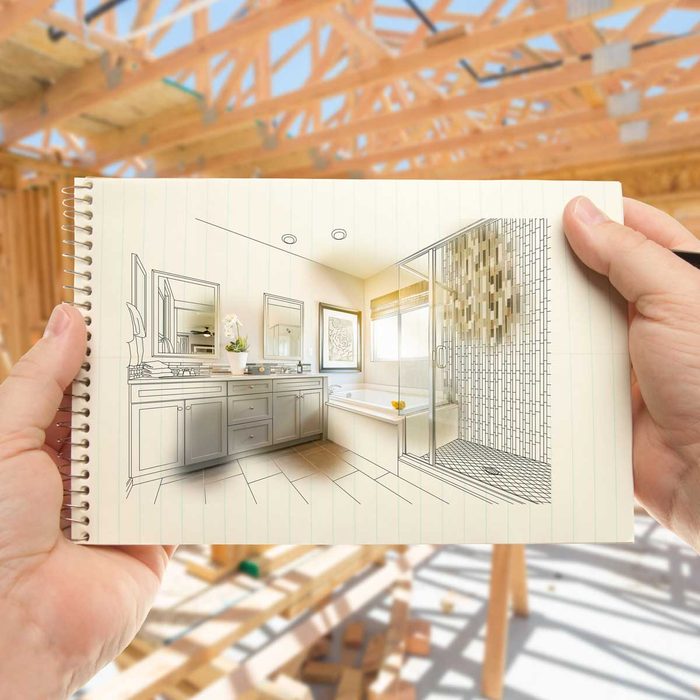Tips for Saving Money When Building a New Home

Labor costs eat up a significant chunk of your home build budget. Opting for a DIY solution when possible and practical can save you thousands.
Time is money, and when you have everyone from a general contractor (GC) to a landscaping team on the clock, the cost of building a new home adds up quickly. One creative way to control the bottom line is by taking on part of the labor yourself.
“Industrious and creative people have many paths to the home of their dreams,” says general contractor and real estate broker Janie Coffey at The Coffey Team – Compass. “You will always want to have licensed professionals for the mechanical, electrical, plumbing (MEPs), but a DIY effort for the non-systems parts of the home can go a long way to stretch a budget.”
This approach is especially doable if you’re building a smaller, more manageable cabin or second home, where stretching out the project over months of DIY-dedicated weekends is less disruptive.
The key to a successful DIY approach is to think things through and know when you may be getting in over your head, warns Tom Kraeutler, host of The Money Pit podcast.
“Sometimes tackling a project yourself saves money and time, but in other cases, it can end up costing you more all the way around,” he says.
“When trying to decide if you should hire a contractor or do it yourself, the first step should be an honest evaluation of whether or not you’re the best person for the job based on your level of skill and experience, as well as how much time you have available.”
If you’re ready to roll up your sleeves and get to work, here are some ways you can save money on your new home or cabin build by hiring yourself.
On This Page
Choose Stock House Plans
You may not be a professional architect or engineer, but you can eliminate the extra expense of custom blueprints by browsing premade house plans to find one that best fits your vision and budget.
Choosing a stock plan is a great option if you have a natural eye for design and can visualize two-dimensional floor plans in three dimensions. You won’t have complete control over your home’s layout, but many blueprint companies offer limited customization services for an additional fee.
You can also hire a professional to make adjustments to the plans, meeting your most important specs while sidestepping the premium price of a fully customized design.
Be Your Own General Contractor
Most states don’t require you to be licensed to be a general contractor for your personal residence. Managing the project yourself can save more than 10 percent of your total building cost.
You will need a basic understanding of the construction process, because hiring and coordinating expert subcontractors will be your biggest responsibility. If you’re a natural problem solver, a people person and good at tracking expenses and timelines, you likely can manage a straightforward cabin or home build.
Keep in mind that when you act as your general contractor, you’re required to take out a builder’s risk or fire policy, effective from when the building materials arrive or the first worker sets foot on the site. You may also need to obtain all relevant building permits yourself, although some architects and subcontractors include this service in their fees.
Purchase Building Materials
When a subcontractor bears the material expense of a number of projects at once, it can be a financial strain. Because you will be billed for things like lumber, wiring or siding anyway, offer to purchase those materials directly from the supplier based on the specs provided by the subcontractor, and pay for them in full.
Subcontractors may be willing to reduce their bids a little if someone else buys the materials. And suppliers may offer a slight discount for upfront payment.
Assemble Wholesale Cabinets and Countertops
Kitchen and bathroom cabinetry is a major line-item cost, but you can snag premium-quality cabinets at a fraction of the normal price by purchasing RTA (ready to assemble) options from a wholesaler. Once the cabinets arrive, assemble and hang them yourself (with an extra helper or two). Many of the top-tier manufacturers also offer customer support if you get stuck.
Premade, standard size marble or granite countertops are also increasingly common. So if you choose a standard kitchen and bathroom layout and install the countertop, you’ll spend about half of what you would on a custom countertop. Custom marble or granite countertops range from $2,000 to $4,500, so going prefab can save you more than $1,000.
Insist on Standard Sizes
Whether you’ve opted for off-the-rack blueprints or splurged on a custom plan, make sure the windows and doors are all standard sizes. Oddly-sized or shaped windows and doors require customization that can drive up the overall cost of purchase and installation. You can also shop around for remnants at construction supply stores that often have standard windows and doors priced to sell.
Comparison Shop to Get the Best Bargains
The more time and energy you invest in comparison shopping, the more likely you are to score high-quality, name-brand finishes and appliances at bargain-basement prices.
Top money-saving tricks include hitting local carpet warehouses for sale-priced remnants; bargain shopping lighting and plumbing fixtures online; purchasing discounted floor models or scratched-and-dinged appliances; and keeping your eye on eBay, Craigslist or other marketplaces for used or repurposed items. And you may be able to negotiate prices — at least it’s worth a try!
Note: You don’t have to be an adept builder to take advantage of this. “When you are doing the legwork on your own, you can be more creative in finding materials,” Coffey says. “A bit of ingenuity and elbow grease as well as being a savvy online, an in-person materials scavenger can go a long way to achieving your dream home. Not all paths are the traditional one!”
Take on Less-Skilled Jobs
If you are your own general contractor, there are a number of jobs unrelated to the MEP systems (only licensed professionals can do most systems-related work) to keep overall costs down. These include wall sheathing, installing batting insulation and drywall, and putting down plywood floor decking and wood flooring.
If you are working with a builder, you may not be allowed to do any building work.
“Check with your local building department as regulations vary, but if are working with a general contractor, you need to get [their] support,” says Tim Bakke, a home building and residential general contractor from The Plan Collection.
“Many contractors don’t or would rather not allow you to participate. Because you’re an unknown quantity, the GC may not want to risk his insurance coverage on you. And because the GC is in charge of meeting deadlines and getting the house finished on budget, [they] need to be assured that you can hold up your end.”
Leave the Final Touches for Yourself
Even if you hired a general contractor, ask them to leave certain final touches out of the bid and take care of them yourself once the main building job is complete. This includes interior painting, staining wood trim and landscaping.
“Just keep in mind that every project requires a certain amount of preparation and a sliding scale of time to accomplish,” says Kraeutler. “Neither of which is obvious in the many popular home improvement TV shows that edit days, weeks and months of hard work down to a few minutes of home improvement bliss.”



